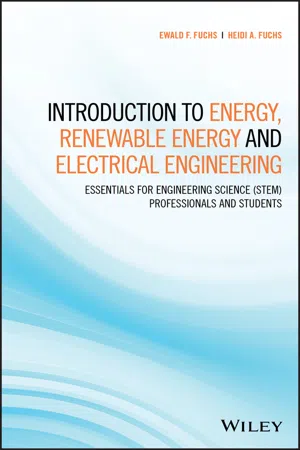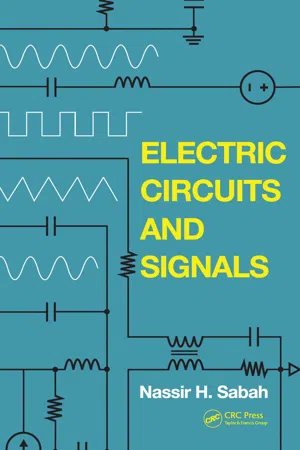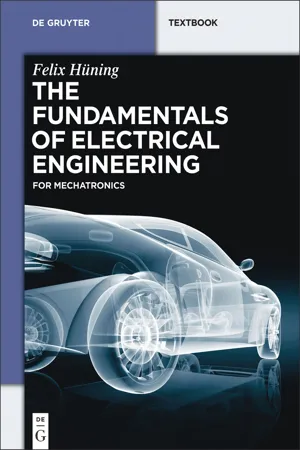Physics
First Order Circuits
First order circuits are electrical circuits that contain only one energy storage element, such as a capacitor or inductor. These circuits can be analyzed using first-order differential equations, and their behavior is characterized by exponential responses to input signals. First order circuits are commonly used in electronic filters, amplifiers, and signal processing applications.
Written by Perlego with AI-assistance
Related key terms
Related key terms
1 of 4
Related key terms
1 of 3
5 Key excerpts on "First Order Circuits"
- Ed Lipiansky(Author)
- 2012(Publication Date)
- Wiley-IEEE Press(Publisher)
4 FIRST- AND SECOND-ORDER CIRCUITS UNDER SINUSOIDAL AND STEP EXCITATIONS4.1 INTRODUCTION
First-order circuits are very important in electrical and electronic engineering. Many higher order circuits can be reduced to a first-order circuit. Analyzing the behavior either in the time or in the frequency domains of a first-order circuit is unquestionably simpler than analyzing that of a higher order circuit. Essentially, first-order circuits have a single energy storage device. Such devices can be either a capacitor or an inductor. Examples of circuits that can be reduced to first-order circuits under certain conditions are electronic amplifiers, operational amplifiers, servomechanisms, electric motors, and other control networks.Let us present an example of a first-order circuit.Example 4.1 RL Series First-Order CircuitGiven a circuit that contains one resistor in series with an inductor, such as the one shown in Figure 4.1 , we can calculate the output voltage to input voltage ratio as a function of frequency. Such ratio of voltages in the frequency domain is commonly referred to as H (jω ), where H (jω ) is called the circuit transfer function.(4.1)Figure 4.1 Circuit for Example 4.1 , a first-order series RL circuit.Previously reviewing the material from Chapter 3 on AC analysis we can easily calculate H (jω ) for the circuit in Figure 4.1 .The current in the RL circuit is calculated as follows:(4.2)where I andVinare respectively the current and voltage phasors of the circuit.Now the output voltageVoutis calculated by multiplying the circuit current times the impedance or reactance of inductor L . Thus, we obtain(4.3)And finally, our transfer function is(4.4)Furthermore, rationalizing the denominator, that is, multiplying numerator and denominator of Equation (4.4) by the complex conjugate of the denominator, (R − jω L ), we obtain(4.5)(4.6)Equation (4.6) is of the form a + jb where the terms a and jb are frequency dependent. Additionally term jb- eBook - ePub
Introduction to Energy, Renewable Energy and Electrical Engineering
Essentials for Engineering Science (STEM) Professionals and Students
- Ewald F. Fuchs, Heidi A. Fuchs(Authors)
- 2020(Publication Date)
- Wiley(Publisher)
3 DC Circuit Transient AnalysisIn this chapter, we examine the behavior of a DC network as a function of time after a sudden change in the network occurs due to opening or closing of switches. The DC network may contain resistors, inductors, and capacitors. First‐ and second‐order ordinary differential equations will be analytically and numerically solved by well‐known solution techniques and numerical methods such as PSPICE [1 –4 ], MATLAB/Simulink [5 ], and Mathematica [6 ]. Note that there are standard resistor [7 ], capacitor [8 ], and inductor [9 ] values. In electric circuit designs, any (certain) resistor, capacitor, and inductor values might be required based on the desired design performance. These certain (e.g. resistance) values are not necessarily manufactured and sold, simplifying the manufacturing process of resistors: only well‐defined resistance values of resistors are manufactured. For example, a design requires the resistance value of 25 Ω; then a series combination of two resistors with standard resistance values of 10 and 15 Ω must be used because 10 Ω + 15 Ω = 25 Ω. For a 6 Ω resistor, the two resistors with standard values 10 and 15 Ω can be connected in parallel such that .3.1 Capacitors
3.1.1 Energy Stored in a Capacitor
Ideal lossless (with no losses) capacitors consist of two conducting plates separated by a nonconducting, or dielectric, material. The simplest capacitor consists of two parallel plates as shown in Figure 3.1 . Note the capacitor is the name of a device having the capacitance C. Any conducting or nonconducting material – which is electrically isolated – can be charged with endowed (see Chapter 1 , Appendix 1.B) electrons and has the property of capacitance C - eBook - ePub
- Nassir H. Sabah(Author)
- 2017(Publication Date)
- CRC Press(Publisher)
Chapter 15 . The discussion is therefore restricted to prototypical second-order circuits that can be reduced to series or parallel connections of resistors, inductors, and capacitors. This serves to highlight some basic circuit principles, without introducing unnecessary complications at this stage.Learning Objectives
- To be familiar with:
- The general features of the responses of switched first-order and second-order circuits
- To understand:
- The need for a transient component in the response of a circuit
- How a general first-order system can be analyzed
- The analysis of prototypical, switched second-order circuits
13.1 Purpose of Transient
The response of a circuit to a given input consists, in general, of two components: (1) a transient component that dies out with time, and (2) a steady-state component that persists as long as the input is applied. It may be wondered why there should be a transient component. In other words, why does the circuit not assume a steady state immediately when the input is applied, at say t = 0? The answer is simply that the steady state may entail a certain value of the response at t = 0 that is different from the value that is compatible with the initial conditions at this time. Something has to happen, therefore, to accommodate these conflicting requirements.Concept:The purpose of a transient response is to match the initial conditions in a given circuit to the steady-state response in the absence of a transient. The time course of the transient is that of the natural response of the circuit.This concept may be illustrated by considering a voltageVmcos(ωt + θ ) applied at t = 0 to a series RL circuit as in Section 5.2 (Chapter 5 - eBook - ePub
- Felix Hüning(Author)
- 2014(Publication Date)
- De Gruyter Oldenbourg(Publisher)
7 Time domain circuit analysisIn previous chapters some concepts for the analysis of electric circuits like mesh or nodal analysis were introduced. So far only DC circuits have been considered, i.e. circuits with time-independent sources (DC sources) and after initial disturbances (e.g. switching and transients) were settled. Even the few examples were sources were time-dependent transient behavior was not taken into account. If time-dependent parameters like current and voltage are considered, lower case symbols are used to describe these parameters, e.g. u(t), i(t).Time domain circuit analysis will be split into two parts:- Transient effects (switching events)
- AC circuits
7.1 Capacitor
A capacitor is an electric element that is able to store electrical energy. In a simplified image an ideal capacitor is built of two plates (electrodes). The electrodes are separated by a non-conducting space (dielectric) and each electrode is connected to one terminal of the capacitor. A current through a capacitor means that positive charges are accumulated inside the capacitor on one electrode and negative charges on the other electrode.Fig. 7.1: A simple image of a capacitor; current i(t) causes positive charges to accumulate on one electrode and negative on the other; circuit symbol of a capacitor (center) and adjustable capacitor (right).A separation of charges means there is an electric field generated inside the capacitor storing electrical energy. The difference of potentials due to the electric field can be measured as voltage u(t) at the terminals. The ratio of accumulated charges q(t) to created voltage u(t) is called the capacitance of a capacitor: - eBook - ePub
- A. L. Stanford, J. M. Tanner(Authors)
- 2014(Publication Date)
- Academic Press(Publisher)
15Direct-Current Circuits
Publisher Summary
An electric circuit is a collection of components through which electric charges may flow. Two components of circuits, resistors and capacitors, were introduced in Chapter 14 . In this chapter we will introduce one more component and begin consideration of circuits that carry steady currents , that is, currents with a constant magnitude. Circuits in which charges flow in only one sense are called direct-current circuits . Finally, we analyze some circuits in which capacitors are charged and discharged through resistors. Such circuits are characterized by transient currents , currents with magnitudes that change before reaching steady-state values.15.1 Energy Reservoirs in DC Circuits
When current is present in a circuit, energy changes continuously take place within the components of the circuit. Resistors convert the kinetic energy of the charged particles moving through them into thermal energy. Capacitors convert the kinetic energy of the moving charged particles of a circuit into electrical potential energy as the charges are accumulated on the plates of the capacitors. When a capacitor is discharged, it converts the electrical potential energy stored in the electric field between its plates into kinetic energy of the moving charged particles in the circuit. Every circuit that carries a steady current must include a component that provides energy to maintain the flow of charges through that circuit.A circuit component that serves as a reservoir of energy in a current-carrying circuit is called an emf (pronounced ee-em-eff). The term emf is an abbreviation for the phrase “electromotive force,” a misleading phrase that lingers although an emf is not, by any means, a force. We will refer to an energy reservoir in a circuit as an emf, which will be symbolized by
Index pages curate the most relevant extracts from our library of academic textbooks. They’ve been created using an in-house natural language model (NLM), each adding context and meaning to key research topics.
Explore more topic indexes
Explore more topic indexes
1 of 6
Explore more topic indexes
1 of 4




